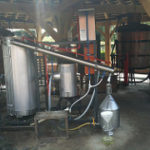The practice of ‘aroma medicine’, rather than the somewhat more vague ‘aromatherapy’, is making very strong gains in the United States. The primary reasons are twofold: Many individuals have become completely disenchanted with our current conventional medical system. We’re paying HUGE amounts of money for very questionable therapies — with many medicines having threatening health warnings (are these making us sicker while making us ‘better’?) accompanying their high price tags. At the same time, people are realizing the value of ‘traditional’ medicines may be far greater than they’ve been lead to believe. That the healing power available in properly prescribed and employed natural medicines have the potential to not only alleviate the symptoms of an illness, but move the body to an equilibrium of long term health.
Research into the area of medicinal applications of essential oils has been significant in recent years. Many oils have been proven to have significant antiviral, antibacterial and antifungal action. Now, the body of evidence of essential oils being strongly anti-tumorial, with specific anti-cancer action is growing, too. A search of Pub Med, the National Institute of Health’s online research database produces 391 results for the search ‘essential oils cancer’ and 444 results for ‘essential oil tumor’. MANY of the studies show a direct correlation in tumor and cancer cell line eradication with the use of essential oils. A great many have conclusions that indicate the studies results warrant further investigation of essential oils for the development of accepted therapies. Here’s a review of some very promising results:
Frankincense has had a place in medicine for as long as medical practices have been documented. The resin from these stout trees of Africa and the Middle East is highly revered for its curative and preventative action (with many spiritual uses as well). In 2009, the journal of Complementary and Alternative Medicine published a studied that outright said Frankincense essential oil kills cancer cells while sparing normal, healthy cells. The oil distilled from the tree’s resin acted specifically on bladder cancer cells, with the study concluding that Frankincense might represent and alternative agent for treatment. Odd that the mainstream media has not made much of this finding — it took a subscription to these abstracts for many interested parties to be notified — otherwise it easily could have gone unnoticed! Frankincense essential oil is well known to be non-toxic, with many people able to put the oil directly on their skin, and even ingest the oil in small quantities without any negative response. Though it can induce cell death with incredible specificity, a feature that absolutely suggests further investigation should be performed — hopefully the medical establishment will agree.
Lemongrass, after Frankincense, may next most commonly researched essential oil for anti-cancer activity. In the May 2009 journal of Chemico-Biological Interactions, researchers tested Lemongrass essential oil against 12 human cancer cell lines. Colon cancer and neuron cancer cell lines were found most susceptible to the essential oil. The study concluded: “Our results indicate that the oil has a promising anticancer activity and causes loss in tumor cell viability by activating the apoptotic process as identified by electron microscopy.” This indicates that Lemongrass may induce natural cell death of cancer cells (apoptotic process), a process that is inherently dysfunctional in cancer cells.
Linalool is a very common essential oil constituent. Essential oils are naturally made up of many individual chemical constituents, and linalool is a sweet, relaxing aromatic found in many floral and sweeter spice essential oils. Linalool itself, separated from the essential oil of Coriander (Cilantro seeds) was the subject of research published in the June 2009 issue of the journal of Chemico-Biological interactions. Linalool was found to completely eradicate the HepG2 liver cancer cell line in VERY low concentrations. Linalool has a great many other effects, having been shown to lower anxiety and even significantly improve sleep. And now it even has anti-cancer effects! So even if one is notle directly targeting cancer, but using aromatherapy in a more ‘casual’ application, there may be important protective effects occurring at the same time.
While the studies above show essential oils potential efficacy at treating cancers of internal organs, a number of studies show oils can both eradicate skin cancers and act as protectants from cancer-causing agents. Sandalwood has a very long history in Ayurvedic medicine, the paste from the wood being used in a great many treatments. The oil distilled from the heartwood of the Sandal tree has been the subject of many studies demonstrating its protective action — the oil has a significant effect in the prevention of tumors when skin is exposed to tumor-inducing chemicals and even UV radiation. Tea Tree oil, a well known antiseptic, exhibited anticancer action by impairing the growth of human m14 melanoma cells — and even showed great effect on those melanoma cells which are resistant to other treatments. Many essential oils have significant antioxidant activity, and may be excellent additions to pre-sun skin lotions to lessen radiation absorption and oxidative radical formation.
Components of Thyme and Oregano essential oils have been shown to actually protect human DNA strands from breaking when exposed to extreme oxidative stress. DNA damage is a leading cause of cancer development, as this can lead to an abnormal cell life cycle, essentially turning off the process of natural cell death. Carvacrol and Thymol were singled out in a study by Slovakian researchers in 2007, though they also note that other components of these oils may have chemoprotective effects as well. Other spice essential oils that have demonstrated cancer preventative effects include Ginger, Tumeric, Basil, Garlic and Sage.
This is but a cursory look into the current body of essential oil research pertaining to cancer treatments. Many not-so-commonly used essential oils display therapeutic effects as well, and there are likely many more plants whose oils are just waiting to be discovered. While it is important to recognize these therapies have yet to be completely defined for sound, effective treatments, there is hope their efficacy will be embraced by the world’s conventional medical systems. Certainly as the costs of technology-based treatments skyrockets, essential oils will continue to look more attractive — particularly to the ‘end users’, or the ‘customers’ of the medical establishment. Please be aware that essential oils can be contra-indicated with many modern cancer treatments (chemotherapy specifically), so be sure a physician is consulted before any oils are used by someone undergoing treatment. Otherwise, essential oils are quite safe when simply therapeutic guidelines are followed, and their wonderful protective effects are already available to all of us.










Leave a reply